White-Tailed Spider
- Article
- White-Tailed Spider
White-tailed Spider
Scientific Name: Lampona cylindrata
How to identify a white-tailed spider
White-tailed Spiders have a dark reddish to grey, cigar-shaped body and dark orange-brown banded legs. The grey dorsal abdomen bears two pairs of faint white spots (less distinct in adults) with a white spot at the tip; the male has a hard, narrow plate or scute on the front of the abdomen. The two common species in southern Australia, Lampona cylindrata and L. murina, are similar in appearance and have overlapping distributions in the south-east. Their bites have been controversially implicated in causing severe skin ulceration in humans.
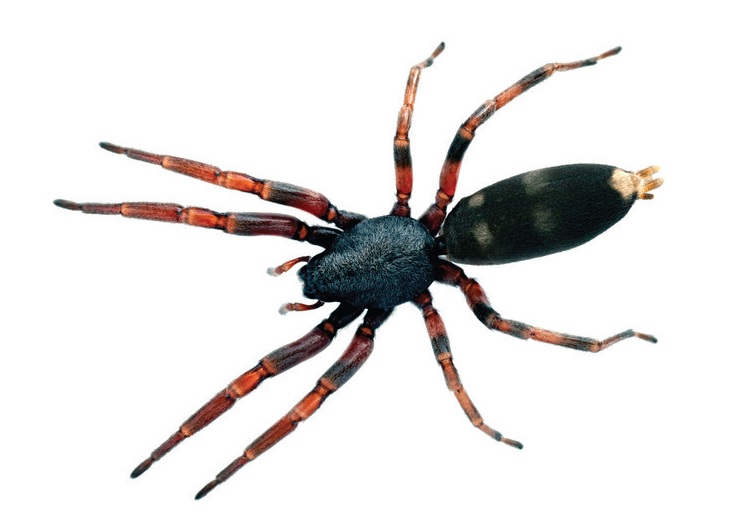
Where are white-tailed spiders commonly found?
White-tailed Spiders are vagrant hunters that live beneath bark and rocks, in leaf litter, logs and detritus in bush, gardens and houses.
Why are white-tailed spiders considered a pest?
White-tailed Spider bites can cause initial burning pain followed by swelling and itchiness at the bitten area. Occasionally, there are unconfirmed reports of weals, blistering or local ulceration - conditions known medically as necrotising arachnidism.
What is the biology and lifecycle of a white-tailed spider?
Tufts of specialised scopulate hairs on the ends of their legs allow them to walk easily on smooth or sloping surfaces. They make temporary silk retreats and spin disc-shaped egg sacs, each containing up to 90 pinkish eggs. Upon hatching, the juvenile spiders are dispersed into the air and start looking for food on their own.
Management Tips for White-Tailed Spider
Keep vegetation and mulch away from the edge of the building, as White-tailed spiders like these cool sheltered areas. White-tailed spiders tend to come inside for two reasons; to find prey or to escape the Summer heat. Their favourite prey are black house spiders, so you can control white-tailed spiders indirectly by applying a general spider treatment to control black house spiders. Without their favourite prey, the numbers of white-tailed spiders will drop off. Keep sheets and clothes off the floor in summer as these will be a favourite hiding place for the occasional invader.
General Spider Prevention Tips
-
Keeping garden beds and rubbish away from the edge of the house will significantly reduce the spider population.
-
If garden beds next to the house are kept in place, it is important to keeping vegetation trimmed back from the edge of the house and paths.
-
Make sure insect screens and draft excluders are in good repair and well fitting
-
Keep clothes and shoes off the floor to reduce spider hiding places.
General Spider Control Tips
-
The best treatment for web-building spiders is to spray their webs and hiding places with an insecticide (ready to use pump back or aerosol). The key tip to get the best performance is to wait a day or two after spraying before brushing down any webs. This ensures the spiders will have picked up a lethal does of insecticide (by walking on the web) and by using a brush (rather than hose), you can ensure the insecticide remains in place to prevent new spiders taking up residence.
-
To prevent web-building spiders take up residence in the first place, spraying around doors, windows and vents, as well as under eaves and guttering delivers excellent results. As these spots tend to be sheltered from sun and rain, the treatment can last many months.
-
It is a lot more difficult to prevent running spiders entering the home. Carrying out a preventative spray around the perimeter of the home and any openings will have some benefit, although running spiders often walk on the tips of their legs, preventing them from picking up a lethal dose of insecticide. However, if you carry out a preventative treatment for web-building spiders and other insects, the numbers of running spiders will be greatly reduced, as there will be little prey for them to feed on.
-
Even with the best control program the occasional spider may get in. A crawling insect aerosol should be kept on hand to spray the occasional unwanted spider. Ensure the spider receives a good dose and keep your distance.
PRODUCT SOLUTIONS
-
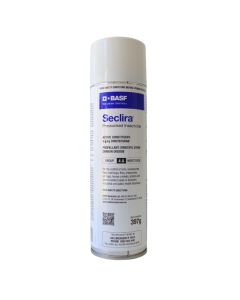 Seclira Pressurised Insecticide 397g5g/kg Dinotefuran
Seclira Pressurised Insecticide 397g5g/kg DinotefuranSeclira Pressurised Insecticide is a fast-acting, non-repellent, ready-to-use product with System III compatibility for the control of a broad range of pests including ants, and cockroaches.
-
 Coopex Dust Insecticidal Dusting Powder10g/kg Permethrin
Coopex Dust Insecticidal Dusting Powder10g/kg PermethrinCoopex Dust Insecticidal Dusting Powder is registered for the control of cockroaches, ants, fleas, silverfish and bed bugs in and around domestic and industrial premises, food preparation and storage areas. Also for control of mushroom flies in mushroom housing and bees in wall cavities.
-
 Biflex Aqua Max Insecticide and Termiticide100g/L Bifenthrin
Biflex Aqua Max Insecticide and Termiticide100g/L BifenthrinBiflex AquaMax is the first ever Professional Strength, multi-insecticide and termiticide. Effective on a wide range of common household pests and all termite species in Australia.
-
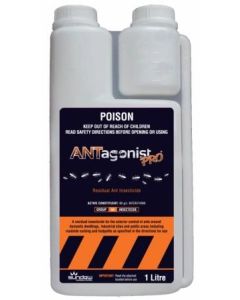 Antagonist Pro Insecticide80g/L Bifenthrin
Antagonist Pro Insecticide80g/L BifenthrinANTagonist PRO insecticide is a suspension concentrate formulation containing a Polymer Enhanced Synthetic Pyrethroid approved for the treatment of ants, spiders, wasps, cockroaches, mosquitoes, midges, fleas, flies, ticks, termites and turf pests including lawn armyworms, sod webworms, argentine stem weevil, billbug, African black beetle, ants and ornamental pest including mites, aphids, caterpillars, loopers, earworm, budworm, light brown apple moth, whitefly, mealybug, thrips and cutworms.
-
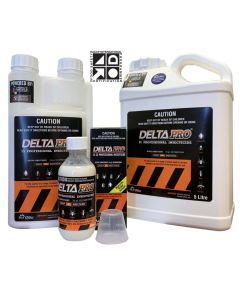 Delta Pro 25SC Professional Insecticide25g/L Deltamethrin
Delta Pro 25SC Professional Insecticide25g/L DeltamethrinFor the control of a range of insect pests such as spiders, cockroaches, flies, ants, mosquitoes in various situations.
-
 Biflex Ultra Lo-Odour 100EC Termiticide & Insecticide100g/L Bifenthrin, 533g/L Liquid Hydrocarbons
Biflex Ultra Lo-Odour 100EC Termiticide & Insecticide100g/L Bifenthrin, 533g/L Liquid HydrocarbonsBiflex Ultra-Lo-Odour Termiticide and Insecticide is a cost-effective, broad spectrum, long residual, liquid insecticide and termiticide for use as an internal and external treatment of a wide range of pests.
-
 Suspend Flexx Insecticide25g/L Deltamethrin
Suspend Flexx Insecticide25g/L DeltamethrinSuspend Flexx Insecticide is a synthetic pyrethroid (3A) formulation for the knockdown and residual control of a range of insect pests in various indoor and outdoor situations.
-
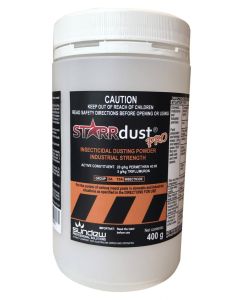 Starrdust PRO One-Shot Insecticidal Dust 400g20g/kg Permethrin, 5g/kg Triflumuron
Starrdust PRO One-Shot Insecticidal Dust 400g20g/kg Permethrin, 5g/kg TriflumuronThe Starrdust PRO One-Shot Insecticidal Dust 400g is an industrial-strength dust designed for use with the Starrdust PRO Duckbill Duster. It is a ready-to-use broad-spectrum insecticide with a unique formulation. It controls a wide range of insect pests including cockroaches, silverfish, spiders, ants, fleas, carpet beetles, bed bugs, European wasps, feral honey bees, bird mites, subterranean termites, hide beetles, millipedes, woodlice and clothes moths.
-
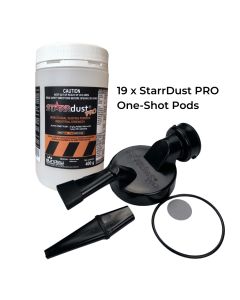 Starrdust PRO One-Shot Insecticidal Dust 19 x 400g + Duckbill20g/kg Permethrin, 5g/kg Triflumuron
Starrdust PRO One-Shot Insecticidal Dust 19 x 400g + Duckbill20g/kg Permethrin, 5g/kg TriflumuronA convenient kit of 19 x Starrdust PRO One-Shot Insecticidal Dust 400g Pods and a bonus Duckbill Duster. StarrDust PRO is an industrial-strength dust designed for use with the Starrdust PRO Duckbill Duster. It is a ready-to-use broad-spectrum insecticide with a unique formulation. It controls a wide range of insect pests including cockroaches, silverfish, spiders, ants, fleas, carpet beetles, bed bugs, European wasps, feral honey bees, bird mites, subterranean termites, hide beetles, millipedes, woodlice and clothes moths.
-
 Tempo Residual Insecticide 1L25 g/L betacyfluthrin
Tempo Residual Insecticide 1L25 g/L betacyfluthrinTempo Residual Insecticide is a fast-acting, knock-down, broad-spectrum insecticide for general insect control in domestic and commercial situations, as well as for the control of pest insects of turf and ornamental plants.
JOIN OUR NEWSLETTER NOW!
Be the first to hear about the latest specials, products, tips and ideas.

